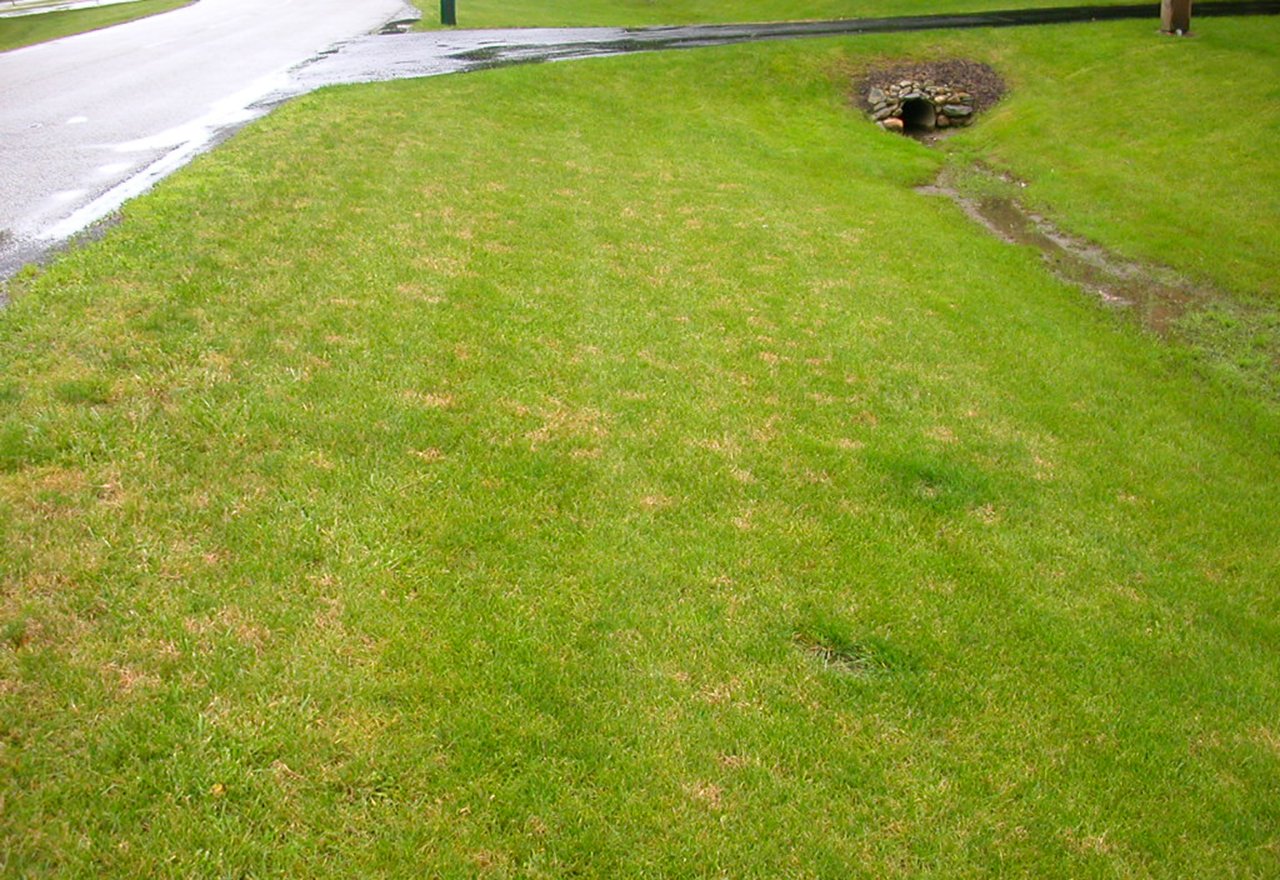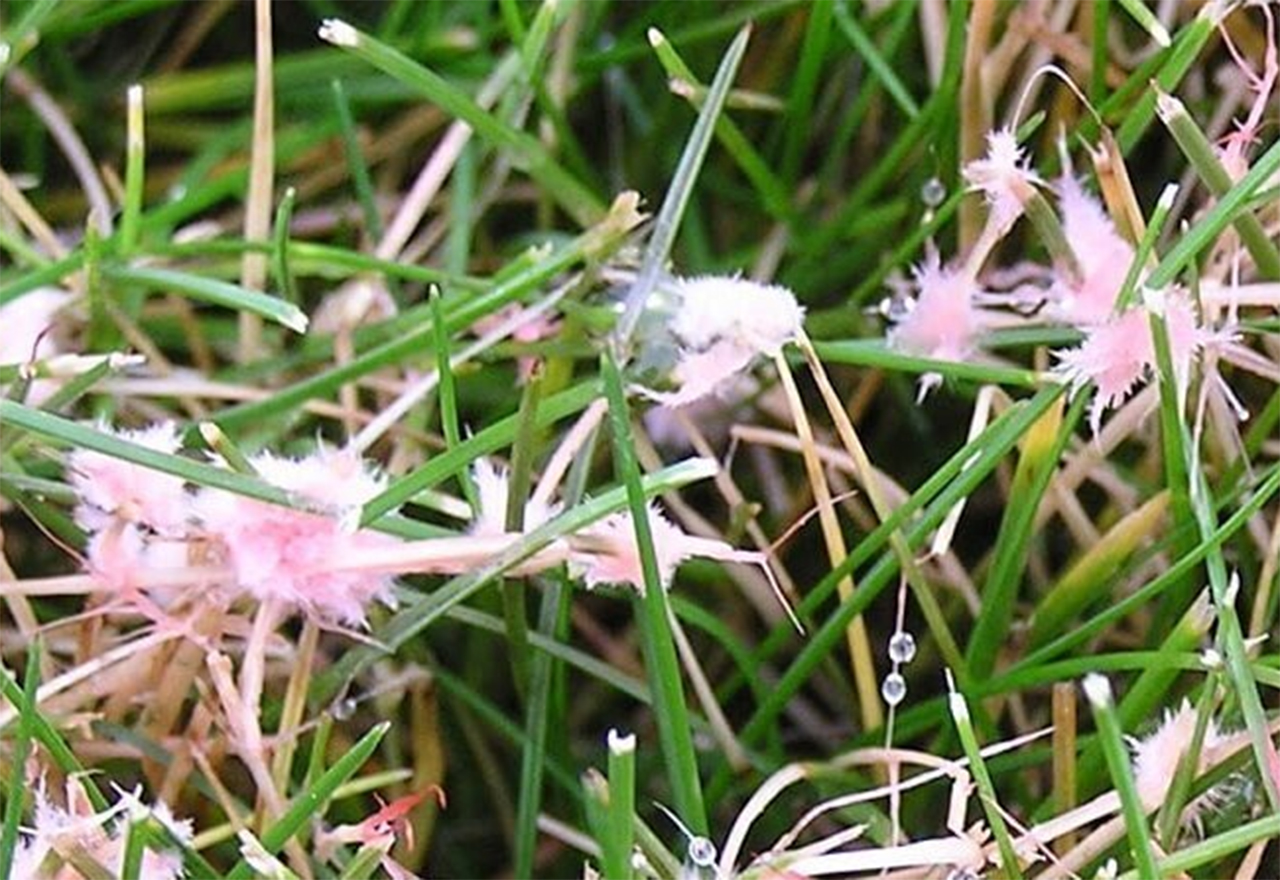A Fungal Organism Causes Turf to Turn Brown and Produce a Pink Fuzz

Pink Patch Disease is very similar to Red Thread Disease and can be treated and prevented the same way. Pink Patch is a fungal organism that causes areas of grass to turn brown and creates tufts of pink fungus that look a lot like little pieces of cotton candy. These cotton candy mycelia are spread by a fungus called Limonomyces roseipellis. Previously, Pink Patch was thought to be a variant of Red Thread Disease, but it has since been discovered that they are caused by different fungi. Both Pink Patch and Red Thread Disease can be unsightly and a bit alarming since they are so odd-looking. Frequently, Pink Patch is easiest to spot in the morning when dew is still on the grass. Both diseases usually occur in the Spring or Fall during wet periods and cool temperatures and most frequently on Kentucky bluegrass, perennial ryegrass, and tall fescue.
It is not uncommon for lawns to get a mild dose of Pink Patch when conditions for the disease are optimal. This fungal disease is really a symptom of improper watering, poor grass, poor soil or all of the above. Pink Patch is most frequently seen on lawns where the grass is not mowed often and when the soil has low nitrogen.
Both Pink Patch and Red Thread are spread the same way: mowers, feet (pets or people) and through wind or rain. Pink Patch Disease enters grass blades through wounds made from cutting the grass. Roots are not affected by the disease, therefore in most cases, the grass will fully recover.
It is normal for lawns to get a mild dose of Pink Patch when conditions are optimal for the disease. This fungal disease is often a symptom of an unhealthy lawn caused by improper watering, poor grass choices, unhealthy soil, or the perfect storm of all three.
The fungus thrives when the surface of the soil lawn is wet and the roots are dry. Also, watering too often will cause the disease to get worse. The solution is to not water more than every 3–4 days per week and make sure to water in the morning or early afternoon, so the grass does not stay wet all night. Water on the blades will cause Pink Patch to grow. Also, one or more rounds of Liquid Aeration will help the water move down into the soil and can make the disease less severe. We also offer Liquid Aerator, a Good Nature at–home product you can purchase online and apply yourself.
Pink Patch is most severe on Perennial Ryegrass, which is susceptible to a lot of diseases, such as Rust, Dollar Spot, Red Thread and more. Builders and landscapers frequently plant Perennial Ryegrass because it sprouts quickly. Homeowners often buy a Perennial Ryegrass and Kentucky Bluegrass blend and seed it at a heavier rate than the manufacturer recommends. However, the Ryegrass takes over because it comes up faster than the Bluegrass. So even though they planted a blend of the two, they end up with a Ryegrass lawn that is susceptible to all kinds of diseases. Our solution is to try Slice Seeding in the late Summer to get some more resistant types of grass in your lawn.
As always, our general recommendation for healthy grass is a mix of 5% Microclover, 90% Turf Type Tall Fescue and 5% Kentucky Bluegrass for the Midwest region of the United States. We sell a pre-made mix at our Good Nature Organic Lawn Care Shop called Tuff Turf Lawn Seed, which provides the Turf Type Tall Fescue and Kentucky Bluegrass. We also sell bags of Microclover that you can mix in. Microclover is a legume known for producing the nitrogen your grass needs to stay lush and green the entire Summer. This variety of Microclover is smaller and does not flower, so it will blend into your lawn well and elevate the overall health and appearance of your grass.
Newer lawns typically don’t have the most biologically active soil, and because of this, are subject to disease issues. The more biologically active your soil is, the fewer problems your lawn will have. Fertilizing organically will gradually build soil biology and improve your soil and your lawn’s disease resistance. If you’d like to speed up the process, you might want to consider Organic Compost Topdressing, Liquid Aeration, and/or Core Aeration.
We do recommend doing a soil test when you think your soil biology is lacking. Contact your Local University Extension Office for tests and best soil nutrient levels for your area. We also offer our own Soil Analysis.
Pink Patch is often a problem in lawns with low nitrogen levels. We have already recommended using Microclover, which will feed the soil the nitrogen it needs to prosper. You might also consider adding agricultural lime to your soil if a soil test shows you are lacking.
When the disease is active on your lawn, we encourage you to decrease traffic to the affected area, so as not to spread to other areas of your lawn. You may also consider fully cleaning your lawnmower and blades after each use and bagging lawn clippings, instead of letting them lay on your lawn (which we usually recommend).
A healthy lawn is the best way to prevent Pink Patch Disease. We have some general organic healthy lawn recommendations. Don't water more than three times per week and only in the morning or early afternoon. Feed your lawn organically, so you don’t kill the organisms that fight disease-causing fungi. We like to add resistant grasses to your lawn that do not contract diseases as easily. Slice Seeding our Tuff Turf Lawn Seed can help add these grasses without an entire lawn replacement. We also like to reduce thatch with Liquid Aeration in the Spring and follow up with Core Aeration in the Fall. While you’re at it, we recommend adding beneficial biology with Organic Compost Topdressing in the Fall. Our general healthy lawn recommendations of mowing high, 3.5–4.5 inches, will also help prevent Pink Patch. All of these recommendations will keep your soil thriving and your grass healthy.
